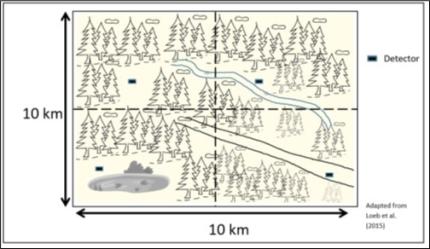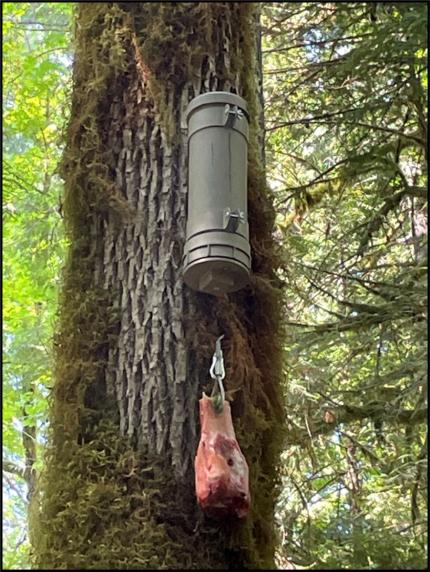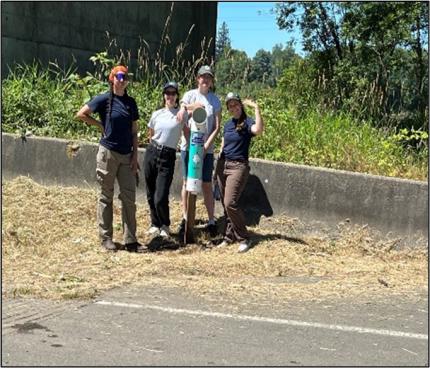Managing Wildlife Populations
Bullfrog Management and Control: Biologists Tirhi and Butler participated in a half day workshop on invasive bullfrog control, removal, and management followed by an evening of training. Their learning included various bullfrog capture and euthanasia techniques and equipment training. District 11 strongly needs to increase their bullfrog management program considering the agency is working hard on listed Oregon spotted frog and Western pond turtle recovery. Both species are predated by non-native bullfrogs and bullfrogs are partially responsible for their demise. The training workshop was organized by the U. S. Fish and Wildlife Service Lacey office while the field capture and dissection training was hosted by Biologist Munes with the Billy Frank Jr. Wildlife Refuge.


North American Bat Acoustic Monitoring: North American Bat Acoustic Monitoring (NABat) is a multi-national, multi-agency coordinated bat monitoring program across North America. Washington Department of Fish and Wildlife (Department) has been a participating agency in NABat across the state for several years. Several biologists in the Department participate and are assigned a 10-by-10 kilometer sample unit that remains consistent year to year. For one to two evenings per year, the biologists deploy an acoustic monitor capable of recording all bats by species and totals in each of the 5-by-5 quadrants of the unit. Biologists Butler and Tirhi completed their assigned NABat monitoring deployment in District 11. More information on the program can be found here.


Western Pond Turtle: Biologist Tirhi and Technician Leopold spent a day at the Woodland Park Zoo processing hatchling pond turtles for the 2023 release to the wild. Pond turtles are a Washington State endangered species and the Woodland Park Zoo has partnered with WDFW for 32 years on the recovery of this important native species. Each year, WDFW brings pond turtle eggs from the Pierce County recovery site to the zoo to hatch and grow for one year. In late July, those hatchlings are weighed, measured, and specially marked in preparation for their release back to the wild (scheduled for August) where they will spend the rest of their lives aiding in the recovery of their population. Over 1,000 zoo visitors visited the event this year. 2023 marks the 32nd year of this Head Start program and one of the longest ongoing recovery programs at WDFW. Media story here.

Fisher Monitoring: Biologists Tirhi and Butler along with Volunteers Terry and Cheney spent several days removing scented camera stations deployed in the fall of 2022 for fisher monitoring (Pekania pennanti). The monitoring is occurring across sections of the south Cascades where fishers were released in the past with one camera deployed per area. District 11 had deployed eight cameras. Tribal, city, state, and federal partners were deployed. Each station contains a camera tree positioned across from a tree containing a skunk lure dispenser, a beef bone, and a band for collecting hair samples. Tirhi and Butler have documented fishers in three of the four cameras checked so far and one wolverine! The other four cameras await check. Cameras took between 800-3,000 pictures each. All eight of the district deployed cameras were functional at retrieval and although bears and cougar (and other wildlife) had visited most, none had been destroyed or camera dislodged.



Bat Maternity Roost Monitoring: Biologists Butler and Tirhi organized a group effort to count bats at the Western State Hospital in Lakewood. This is an annual survey that involves a minimum of seven people to conduct. Staff members and volunteers stage themselves outside the various buildings and count bats as they emerge from their roost locations in the attics and crawl spaces of the hospital. Bats have occupied the attic spaces of these buildings for over 30 years. WDFW has partnered with Washington Department of Social and Health Services (DSHS), who runs the hospital, to separate the bats from the staff and patients and manage all facets of the colony occupation. Bats occupy three known roost locations from spring to summer and are comprised of females raising pups. There are likely other smaller unknown locations that non-breeding females and males use on the grounds. This year the count was down from approximately 500 in 2022 to approximately 250 this year. This could be due to observer error, changing flight patterns of the bats, or a true population decline. WDFW focuses on longer term trends rather than year-to-year declines. Regardless, the hospital is one of several colonies that WDFW is annually monitoring trends to determine whether White Nose Syndrome is affecting Washington’s bat colonies as it has on east coast populations. This year also featured a media event to showcase how DSHS and WDFW are working together to conserve bats and run a hospital including the replacement of one of the buildings housing a bat colony. WDFW appreciates the commitment of DSHS in helping conserve Washington’s valuable wildlife species.
Snowy Plovers: Biologist Cent checked on the last of the active plover nests. All known nests have now hatched or failed, though plovers are still in the area. Two nests at Midway were confirmed to have hatched a total of three chicks. All other nest fates were unknown.
Band-tailed Pigeon: Biologists Cent and Novack completed annual counts at known mineral sites. Grays Point, along the Columbia River, was surveyed for the first time with assistance from the Spartina Crew Member Mikkelsen and an airboat. District 10 Biologist Holman brought a boat from Region 5 to assist with the survey at the Cosmopolis site. Moclips mineral site had low numbers this year (45 birds), but Biologist Novack confirmed that some birds use the site further upriver and out of sight of the previous survey location.
| Site Name | Total |
| Cosmopolis | 187 |
| Grays Point | 36 |
| *Naselle | 22 |
| *Moclips | 45 |
Biologist Novack arranged visits to newly discovered mineral sites for confirmation from U. S. Fish and Wildlife Services (USFWS) Biologist Sanders. Waterfowl Section Biologist Hamer assisted with providing boat access to sites in the Willapa River and Clallam Bay. District 16 Biologists Ament and McMillan guided them to three sites within Clallam County.

Mourning Doves: Biologist Cent began trapping at one of District 17’s mourning dove trapping sites. Ten birds have been trapped and banded since trapping began. The second site where trapping occurs each year has yet to have a significant number of doves show up, though the landowner continues to bait each day. Hopefully, trapping will begin at this second site in the next week or two.
Mariposa Copper Butterflies: Biologist Cent began collection of mariposa copper butterflies at North Bay Bog, a Department of Natural Resources property in Grays Harbor County. She is also scouting the Elk River Unit, which is a site which once had wild cranberry bogs, the habitat of mariposa copper butterflies, to determine if the wildlife area is home to any coppers.
Black River Elk Capture: Biologists Novack and Cent attempted to capture and collar a cow elk at the USFWS Black River site near Littlerock with assistance by USFWS Manager Nakai and the Nisqually Refuge biologist. The objective is to track the movements of these elk that are in close proximity to I-5 and create conflicts with private landowners. A group of 43 elk were found in the open fields and Biologist Novack was able to get into range for placing a tranquilizer dart. Unfortunately, almost every adult cow appeared to be afflicted with Treponeme-associated hoof disease and were not suitable candidates for placement of a telemetry collar. Another effort will occur in winter when migratory elk come to the property that will likely have some healthy elk.
Western Pond Turtle: Biologist Murphie deployed two artificial basking structures at the Western pond turtle recovery site in District 15. A PIT tag (passive integrated transponder) antenna array was also placed at the pond and fitted to one of the platforms. Trail cameras were placed to collect images of turtles using the platform. Over 300 turtles were released in this pond from 2005-2013. All the turtles released are uniquely marked and have PIT implant. The objective of this new effort is to see if the PIT tag antenna array can identify remaining turtles released into the pond. Secondarily, we are looking for turtles that are unmarked and potentially new recruits hatched at the pond. Biologist Murphie has counted 36 turtles basking at various locations around the pond, but so far it doesn’t appear like they are using the platforms. Stay tuned, as adjustments to antenna placement and number of antennas deployed are made.
Bear Hair-Snare Project: Biologist Murphie along with carnivore section and regional staff set up 36 stations in GMU 636 to collect hair samples from bears from May through July. If successful, the project will provide an estimate of bears in GMU 636. Biologist Murphie reports collecting 744 samples (a sample can be an individual hair or a cluster of many hairs) at the conclusion of the sampling phase. On camera, visitors included turkey vulture, deer, squirrel, bobcat, cougar, spotted skunk, grouse, unidentified weasel, raccoon, and bears. More to come, as analysis from this project is completed over the next few months.
Bat Counts: Biologist Murphie participated in bat counts organized by U. S. Forest Service (USFS) biologists at the Snider Work Center and the Intorem Cabin on the Duckabush.
Band-tailed Pigeon Mineral Site Counts: Biologist Murphie conducted counts of band-tailed pigeon at two mineral sites in District 15. He reports count totals were at or below previous years. Additional analysis will generate the final index for these sites.
Providing Recreation Opportunities
Band-tailed Pigeon: Biologist Tirhi conducted the annual band-tail pigeon survey of the Mud Bay mineral site. Tirhi counted 220 band-tails using the site this year compared to 239 in 2022 and 263 in 2021.
Hunting Prospects and Status and Trend Reports: Biologist Murphie completed a first draft of the 2023 District 15 Hunting Prospects. He also completed the first draft of the Olympic goat status and trend report and started the Olympic deer status and trend report. Other data work associated with these write-ups was also completed.
Pierce County, American Lake: Region 6 water access staff have been working around the influx of users at water access areas. While vegetation control is a large part of access staff regular duties, these projects are often difficult to accomplish due to the hazards of navigating around vehicles and pedestrians. The other main consumer of time during the summer season is litter collection. Usually, a handful of water access areas will contribute to 90 percent of the litter collected throughout any county. In recent weeks, the recreational activity and litter collection at American Lake Access Area has been above and beyond the normal seasonal increase. The past three weeks of routine maintenance visits has accumulated over 1100 pounds of litter collected. The most recent visit consisted of 600 pounds and over seven hours logged for collection and disposal. The previous maintenance visit, just one week before, tallied 280 pounds of litter collected. Access staff and Enforcement are looking for ways to help improve this ongoing issue.


Grays Harbor County, Black Creek and South Montesano: Region 6 water access staff members worked with Washington Conservation Corp (WCC) crew on expanding the monofilament recycling programs collection bins. This recycling program has proven successful with collections bins at WDFW access areas in Kitsap, Mason, Pierce, and Thurston counties. The collaboration of the water access team and WCC has been favorable to both programs. They have increased recycling efforts and planed an expansion at other water access areas in the remaining Region 6 counties starting in Grays Harbor. Recycling bins were installed at four access areas: Black Creek, South Montesano, Double Bridges and Fuller Bridge. Plans to install additional bins in Grays Harbor, Clallam, Jefferson, Pacific counties will continue in the weeks to come.


Kapowsin Lake: Region 6 access team prepared and arranged for new striping, directional arrows, ADA parking, walkways, and speedbumps at Kapowsin Lake. The previous striping was no longer visible, and the parking structure was all but lost. These improvements should help users navigate the parking areas much easier and once again have areas designated for those with disabilities. This is part of a larger effort by the water access crew to steadily bring this access to better overall condition. A pattern of misuse, vandalism, and vegetation overgrowth had this site in poor condition.
Conserving Natural Landscapes
Rat Island: Wildlife Area Manager Laushman and Biologist Norris put up signage at the Marrowstone Unit of North Olympic Wildlife Area to close Rat Island due to an outbreak of avian influenza.

Group efforts from the Wildlife Program have helped reduce the viral load of avian influenza at the Marrowstone Unit of North Olympic Wildlife Area. The main part of the unit is closed due to an outbreak of avian influenza in Caspian terns. Biologist Ament, Water Access Team Members McKinlay and Walker, Wildlife Area Manager Laushman, Wildlife Veterinarian Haman, Technician Norris, and Safety Manager Mundy traveled to the island to remove tern carcasses and assess the colony.

South Puget Sound: A new gate was installed for the South Puget Sound Wildlife Area in Lakewood to reduce trespassing.

Chehalis Unit Acquisition: Biologist Novack provided some information to Real Estate in preparation for the upcoming Commission meeting when a 40-acre acquisition will be proposed.
Union River: Wildlife Area Manager Laushman, Habitat Engineer Lockwood, Habitat Restoration Coordinator Waldbillig, and Grants Manager Weller conducted a tour of the Theler Wetlands, adjacent to the Union River Wildlife Area Unit to discuss future restoration ideas with partners at the U. S. Fish and Wildlife Service and the Hood Canal Salmon Enhancement Group.

Bell Creek: Wildlife Area Manager Laushman, Assistant Regional Wildlife Program Manager Blankenship, and Assistant Lands Division Manager Lowery met with long-time volunteers and partners with the Department of Natural Resources and other local groups at the Bell Creek Unit, part of the North Olympic Wildlife Area. The group met to discuss next steps for the oak woodland restoration project that has been on-going at the unit for over 20 years, thanks to dedicated volunteer support.

Skokomish: Wildlife Area Manager Laushman cleaned up trash at the Skokomish Unit and refreshed signage.

Providing Education and Outreach
General Wildlife Inquiries: Biologist Murphie responded to inquiries received by phone, email, and in person related to deer, rabbit, bear, and a bat.
Conducting Business Operations and Policy
Aircraft Safety Course Instruction: Biologist Murphie conducted a basic aircraft class in Montesano during the review period. The next one is scheduled for August.
Chemical Immobilization: Biologist Murphie conducted final turn-in and destruction of expired immobilizing drugs for the District 15 station, as the station is being closed. Associated paperwork has been completed.
Meetings Attended: Biologist Murphie participated either in-person or online in meetings discussing cougar, sooty grouse surveys, deer surveys, and the Avian Influenza outbreak on Rat Island.
Other
Drug Coordination: Biologist Novack conducted administrative duties relating to chemical immobilization drugs. He supplied Enforcement with chemical immobilization drugs and destroyed excess drugs that were past their expiration. Inventories and logs have been updated.